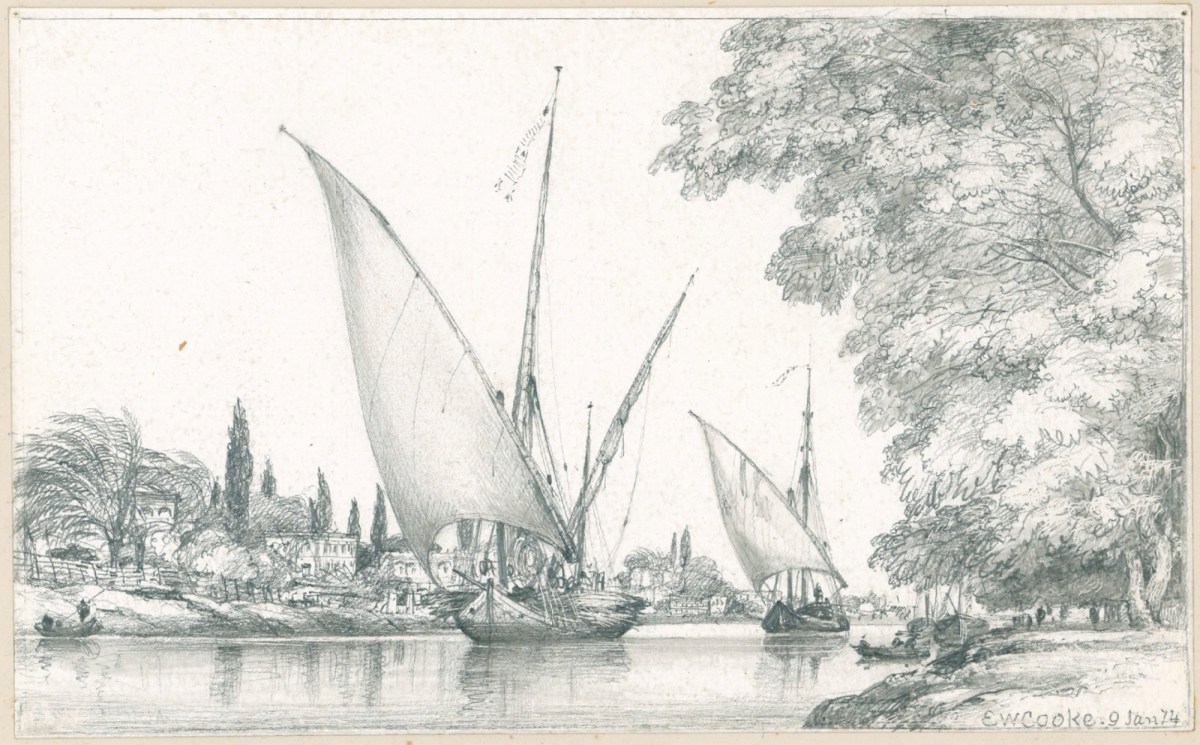
Edward William Cooke RA, The Mahmoodeeah Canal, Alexandria, January 9th 1874.
Pencil on wove paper. 111 mm x 184 mm. © Photo: Royal Academy of Arts, London.
This image is not available to download. To licence this image for commercial purposes, contact our Picture Library at picturelibrary@royalacademy.org.uk
The Mahmoodeeah Canal, Alexandria, January 9th 1874
Edward William Cooke RA (1811 - 1880)
RA Collection: Art
E. W. Cooke visited Egypt in the winter of 1873-4, travelling to Brindisi where he boarded the Simla steamer. En route he met John Fowler and Richard Owen and travelled with them for part of the way. All three stayed in Alexandria in early January before Cooke set off down the Nile on a dahabieh (or houseboat) named the Queen Victoria, visiting Feshan, Sohag, Luxor, Karnak, Aswan and various other sites on the way. Cooke sketched as he sailed down the river, and his drawings demonstrate his particular interests in botany and in the variety of sailing vessels to be found on the Nile. According to John Munday, Cooke's 'pencil studies of Egyptian subjects (there is a good example in the Royal Academy collection) show his careful assembly of references, the architecture, palm trees, grouping of figures, camels, boats and landscape, are of course drawn with possible future needs in mind. He worked at his oil sketches in uncomfortable conditions and his scientific interests dictated some of the subjects'.
In the second edition of his book Leaves from my Sketchbook (1877) Cooke published sixteen plates of Egyptian scenes and in the commentary expressed great admiration for the elegance of the Egyptian dahabieh when he wrote 'a steamer is not a beautiful object anywhere, but...a Nile boat, ... no matter how shabby, always looks well by virtue of the graceful shaped sail'. However, despite the fairly high quality of the plates, Cooke was dissatisfied with the reproductions of his drawings, complaining in a letter that the book had been printed and published 'without my being consulted as to the Plates or the Descriptions - all horribly bad and so black and coarse and vulgar'.
This group of 100 drawings consists of travel sketches by E.W. Cooke. They come from a stock of over 20,000 that the artist produced over the course of his career. Following the early death of his wife in 1844, Cooke developed a peripatetic lifestyle, travelling extensively in Britain and Ireland as well as making regular visits to Holland, France, Italy, Germany and Switzerland. He also toured Spain, Egypt and Sweden. Whilst travelling, Cooke filled scores of sketchbooks with his meticulous pencil drawings of seascapes, landscapes, architecture and local scenes. Given the highly detailed nature of his drawings it is perhaps unsurpising that Cooke also made use of a camera lucida and photography in his work.
Cooke's travel sketches were generally made with subsequent engravings or oil paintings in mind and his habit was to take his sketchbooks apart on his return and file them in order. The drawings were later mounted by the artist's sisters, with whom he shared a house. There was a studio sale of Cooke's work shortly after his death in 1880 but this group of drawings was retained by his family and presented to the Royal Academy at a later date.
Many of the drawings were engraved and published in the two editions of Cooke's Leaves from my Sketchbook (1876 and 1877). In the introduction to these publications Cooke wrote, 'Travels in many countries, extending over a period of fifty years, have filled my Sketch-books with several thousand sketches, which have often served to recall to friends pleasant memories of happy days and sunny climes, and excite a wish to visit places alike remarkable for natural beauty and historic interest.'
Object details
111 mm x 184 mm
Start exploring the RA Collection
- Explore art works, paint-smeared palettes, scribbled letters and more...
- Artists and architects have run the RA for 250 years.
Our Collection is a record of them.



